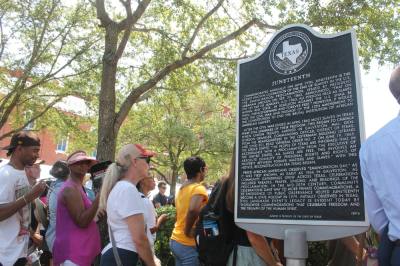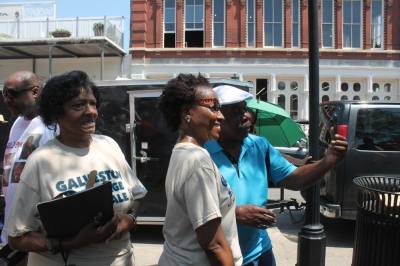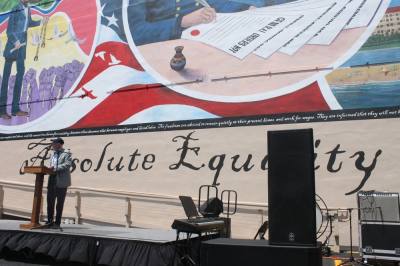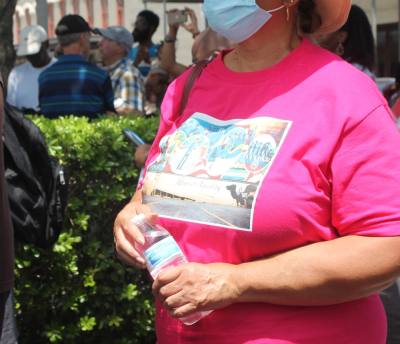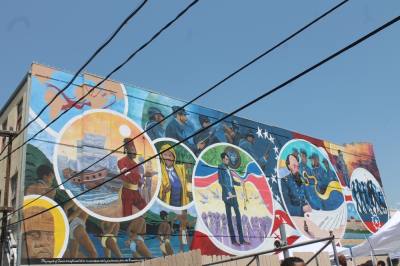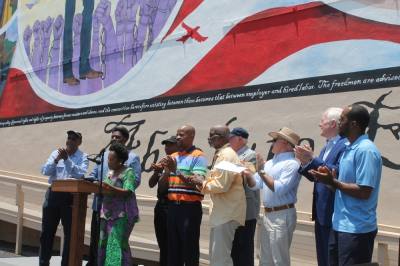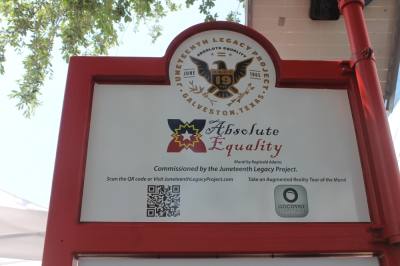About half an hour before noon on June 19, the words of Martin Luther King Jr. rang throughout the historic Old Galveston Square area.
Members of the Galveston Heritage Choir kicked off a Juneteenth celebration at 22nd and Strand streets by singing out a line King delivered in his famous “I Have a Dream” speech: “Free at last, free at last, thank God almighty I’m free at last.”
Thousands of people from the Houston and Galveston areas and beyond braved the heat to listen to the singers as well as local policymakers, historians, artists and philanthropists, discuss the significance of the Juneteenth holiday and dedicate a 5,000-square-foot mural on the east elevation wall of the Old Galveston Square building.
Juneteenth honors the day in 1865 when Union Gen. Gordon Granger came to Galveston to announce the liberation of enslaved people in Texas—more than two years after the Emancipation Proclamation became official in 1863.
This is the first year Juneteenth is recognized as a federal holiday, which came about after a bill passed in the U.S. Senate earlier in the week and was signed into law by President Joe Biden on June 17. The bill was introduced by U.S. Sen. John Cornyn, R-Texas, U.S. Rep. Sheila Jackson Lee, D-Houston, and U.S. Sen. Ed Markey, D-Mass.
Lawmakers raced this month to get the legislation adopted and make Juneteenth a federal holiday, Jackson Lee said.
“As [the bill] came to the House, we had to run to get the papers from the Senate,” she told Galveston audiences as she stood in front of the mural. “We did this bill in six hours on the floor of the House. Something about that word, ‘Juneteenth.’”
Those involved with commemorating and celebrating Juneteenth in its birthplace said they hope the mural’s dedication can be the catalyst for a true Juneteenth legacy in the Houston and Galveston areas.
The mural spot was chosen in part because it overlooks the site of Granger’s headquarters, which were at the former Osterman Building on 22nd and Strand, according to the Galveston-based nonprofit Juneteenth Legacy Project’s website. One of its creators, Reginald Adams, spoke at length during the dedication about how the work has an evolutionary narrative.
He and other creators emphasized the mural is meant to illustrate how Black people came to the area first as explorers and have since contributed in various ways to the advancement of American society. Enslavement does not mark the beginning of Black history, speakers said—not with their various other contributions to culture, music and science.
“We wanted to make sure this narrative didn’t begin [with] Africans arriving as slaves,” Adams said.
Listen to the 5,000 square foot mural’s artist, Reginald Adams, talk about the project’s impact: pic.twitter.com/nA249BHK46
— Colleen Ferguson (@ColleenEFergus2) June 19, 2021
Destroying ignorance with knowledge
About two weeks before the event, Juneteenth Legacy Project co-chair Sam Collins spoke at League City’s Helen Hall Library on June 7 about the nonprofit’s goals. The knowledge provided—both through looking at the mural and participating in an augmented reality historical tour experience—is meant to destroy ignorance and grow knowledge, he said.
Collins, a Galveston-area native and historian, compared American society to a giant house, also comparing American history to a green salad.
“We all live in this American house. As current citizens, we’re on the deed of America's property, and it’s our job to fix it,” he said, adding the mural project is, for this reason, much more than paint on a wall. “There's no other place in the world I’d rather be than Texas, but we need to repair some of the wiring in here."
In a green salad, he continued, one typically encounters the most lettuce and tomatoes, but other ingredients also add flavor even if not noticeable. Collins said American history can be looked at the same way: The stories heard more commonly are the lettuce and tomatoes, but lesser-known stories like the history of Juneteenth are the other ingredients that still add flavor.
“We too are Americans, and we too want to be celebrated,” he said of Black historians and activists like himself aiming for representation in history, art and culture.
Part of authentic celebration, he told Bay Area residents on June 7, means ensuring people know the real version of the Juneteenth story.
While it is generally portrayed as Granger reading off his General Order No. 3, which explicitly freed the formerly enslaved, from the historic Ashton Villa along Galveston’s Broadway Avenue J, the real story involved more travel for Granger, Collins said. The general had to visit numerous plantations and more rural sites to ensure the word properly spread.
Moreover, the factually accurate history includes the fact that Africans had at one point sold each other, Collins said. This is depicted on the mural.
“We’re not running from the truth of the story,” he said.
Honoring Black migration
Jackson Lee and Cornyn were both present at the June 19 festivities, as both have long been involved in the preservation of Houston’s Black legacies. Cornyn has been the lead author of a resolution honoring Juneteenth each year since 2011, according to a June 15 media release from his office. Meanwhile, he and Jackson Lee also authored a bill for a federal study of a National Emancipation Trail from Galveston to Houston.
The bill related to the trail was signed into law in March 2020, and the trail area is currently being studied. It would follow the path of former slaves who had learned of their freedom, spanning across a 51-mile stretch of land from Galveston to Houston; this would be one of just two historic trails in the U.S.honoring Black migration.
While newly freed Black Texans may not have had an understanding of fair wages and employment at the time of their liberation, Jackson Lee said June 19, they did understand liberation. They understood there was a road to freedom, and it was now accessible to them, she said.
Jackson Lee told the audience several times how full her soul felt this Juneteenth.
“On this day in history, I am filled,” she said.





